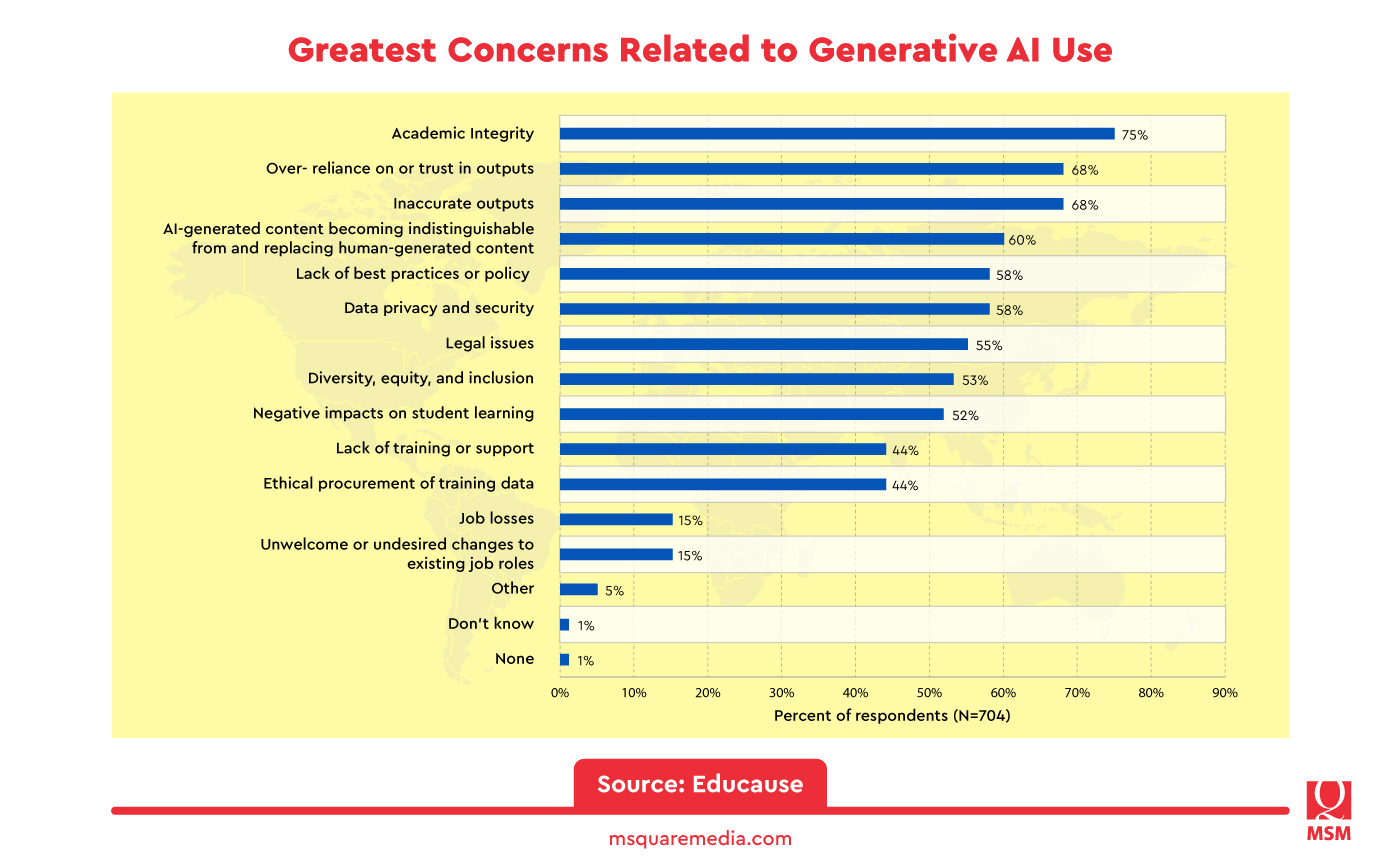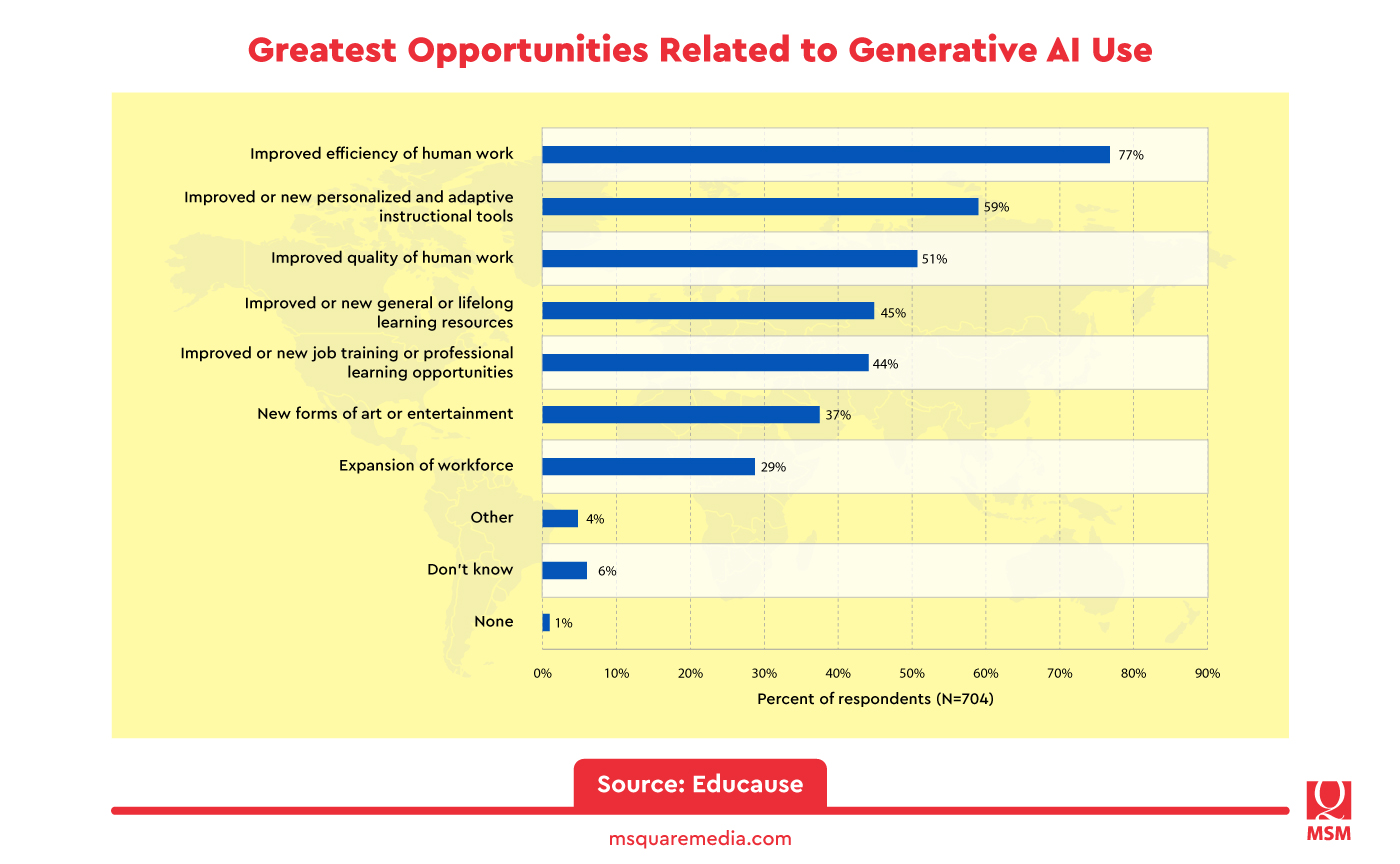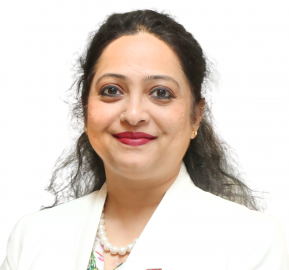Key Takeaways:
- According to a quick poll by Educause, 75% of the respondents believed that cheating is the top concern when it comes to generative AI.
- Other common challenges include the lack of best practices for policy (58%) and data privacy and security (58%).
- According to the QS Global Employer Survey conducted in 2022, 80% of education sector employers felt that AI was important to their organization.
Artificial intelligence (AI) is changing how we live and work, and higher education is no exception. International higher education is more important than ever because it gives students from all over the world a chance to work together and learn from each other.
At the same time, the rise of artificial intelligence (AI) could change higher education in ways that nobody could have thought of before. AI-powered tools and platforms can make learning more personalized, decision-making based on data, and educational processes more efficient. But there are also problems with using AI in higher education, especially when it comes to international education.
Today, AI systems like ChatGPT are making waves after their official launch in the digital space. However, stakeholders remain uncertain about their potential promises and risks, especially in the international education sector.
In this current era of the AI age, how can international education thrive?
Challenges

According to a quick poll by Educause, the biggest worry about generative AI is cheating, with academic integrity being the strongest concern for 75% of the people who took the survey. Concerns about the results of generative AI are also common. These include putting too much trust in the results (68%), the results being wrong (68%), and AI-generated content becoming indistinguishable from human-generated content and replacing it (60%). Other common problems are a lack of best practices for policy (cited by 58% of respondents) and a lack of protection and security for data (58%). Respondents also noted other challenges, including misplaced concerns, overreactions, and an overemphasis on enforcement and punishment. To effectively and safely use these tools, everybody involved will require an uplift in their digital dexterity.
Another challenge is the potential for the displacement of human teachers and other educational professionals. AI can help teachers in a lot of ways, but it can’t replace the human link and emotional intelligence that are key to good teaching and learning. In international higher education, it is important to find a balance between the use of AI and the continued importance of human interaction and engagement.
Opportunities
Before ChatGPT’s release in November 2022, it was already apparent that many K-12 and higher education organizations valued AI expertise highly. (AI). Eighty percent (80%) of education industry companies valued AI highly in 2022, per the QS Global Employer Survey. This suggests that businesses see the significance of AI in the classroom and are actively looking to hire people with the expertise to integrate AI into a variety of settings.

From classroom instruction to back-end management, generative AI could have a profound impact on the future of higher education. Respondents to an Educause poll were optimistic that generative AI could improve the quantity and quality of human labor in the education sector. Some 77% of people polled thought generative AI could be used to make humans more productive. The majority of respondents (59%) believe that generative AI can improve the quality of human work (51%), and 59% believe that generative AI could improve the creation of personalized and adaptive instructional tools. Overall, respondents were optimistic about the potential of generative AI in education, with less than 1% believing that it provided no opportunities.
Moreover, respondents identified other areas of opportunity for generative AI in education. For instance, some respondents hoped that the technology would help pull intellectual curiosity back from obscurity in the age of teaching-to-the-test. Others felt that generative AI could be used to help students analyze the output from the technology to enhance their learning or to shift the educational model toward one that is process-based, authentic, reflective, and meaningful. Additionally, generative AI could free up human resources to focus on other more humanistic and/or creative endeavors, as well as provide new ways to spark creativity and get unstuck.
Moving Forward
Generative AIs, while potentially dangerous to academic integrity and other areas, can be useful when run by humans. It can be used as a translator, making it simpler for students in nations where English is not the official language to gain access to English-language learning materials. It can function as a smart teaching system, tailoring lessons to each student’s unique preferences and strengths. In addition, it can be put to use as a study tool, making it easier for both students and teachers to scour and make sense of massive amounts of scholarly literature and data.
In addition, AI tools can help automate administrative chores like scheduling, registration, and grading, giving teachers more time to concentrate on what really matters in the classroom: fostering student engagement and developing engaging lessons.
The era of AI opens up a wealth of possibilities. The point is, we shouldn’t be afraid of this kind of technology; rather, we should learn to live alongside it.
The coexistence of AI and international education represents a transformative opportunity for educators and learners alike. By leveraging the power of AI, we can enhance the quality, accessibility, and inclusivity of education, breaking down barriers and fostering a more globally connected and diverse community of learners.
In this way, international education leaders and stakeholders can ensure they remain at the forefront of global education in the coming years. (SUNEETHA QURESHI)

SUNEETHA QURESHI
MSM President
Suneetha has worked for 15 years in the international education sector and 25 years overall for her work for other industries. As president of MSM, she fortifies its business development outreach globally, particularly in the face of MSM’s foray into edtech-based recruitment via MSM Unify. She preserves the premium, value-adding services provided to each MSM partner institute, including dedicated teams on the ground, agent management, lead generation and inquiry management, application prescreening, and student and parent support through pioneering pre-departure briefing sessions.
She has an impeccable track record of successfully launching the representative offices in Asia and Africa of many North American and European higher education institutions. Her key strengths include hiring, training, and developing teams as evidenced by the successful results of the dedicated in-country college and university client teams.
Suneetha also has taken the lead in developing several initiatives at MSM, including building robust standard operating procedures, the Rise ‘n Shine team engagement platform, and the organization’s data analytics and audit segments.
Sources:
- EDUCAUSE. (2023). EDUCAUSE QuickPoll Results: Did ChatGPT Write This Report?. Retrieved from https://er.educause.edu/articles/2023/2/educause-quickpoll-results-did-chatgpt-write-this-report
- West, D. M. (2023, February 22). Poll: Majority of Higher Ed Leaders Optimistic About Generative AI. EdTech Magazine. Retrieved from https://edtechmagazine.com/higher/article/2023/02/poll-majority-higher-ed-leaders-optimistic-about-generative-ai
- Davis, N. (2022, October 20). Artificial Intelligence in Higher Education: Benefits and Ethics. Fierce Education. Retrieved from https://www.fierceeducation.com/technology/artificial-intelligence-higher-education-benefits-and-ethics
- QS Quacquarelli Symonds. (2022, September 1). What is Machine Learning and How Can It Help Your Institution Convert Student Enquiries and Offers More Effectively? Retrieved from https://www.qs.com/what-is-machine-learning-and-how-can-it-help-your-institution-convert-student-enquiries-and-offers-more-effectively/

